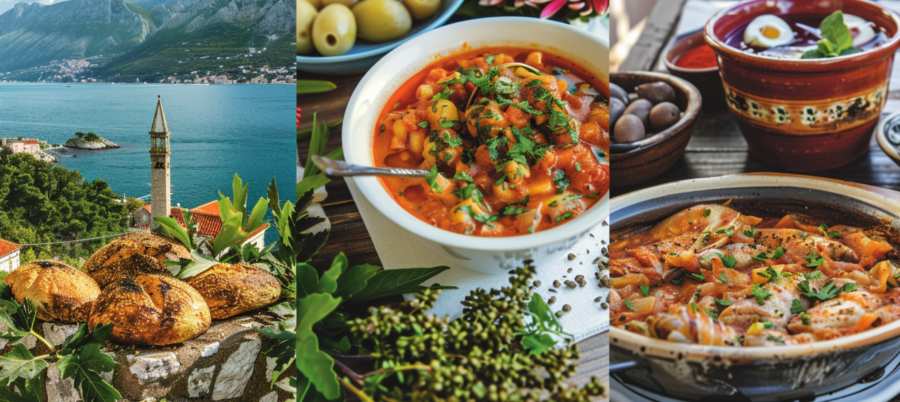Exploring Podgorica’s Market Treasures
The capital city of Podgorica is more than just its historical sites; it’s a haven for food lovers. The local markets here are bustling with vendors offering a variety of fresh produce, cheeses, and meats. One might think, “What’s the big deal about a market?” But this is where the magic begins.Strolling through the market, you might find yourself greeted by a cheerful vendor offering a taste of Njeguški pršut, a smoked ham that’s a local favorite. It’s like prosciutto, but better. Pair it with some homemade cheese and bread, and you’ve got yourself a picnic fit for a king. Just make sure to leave room for the next surprise!
Kačamak: The Ultimate Comfort Food
Kačamak, Montenegro’s answer to mac and cheese, is a hearty dish made from cornmeal and potatoes, often enriched with a generous helping of cheese and cream. It’s the kind of meal that makes you want to curl up and take a nap afterward – in the best way possible.This dish is typically enjoyed in the mountainous regions, where the cool air makes you crave something warm and filling. Finding a small, family-run restaurant that serves Kačamak is like discovering a culinary gem. It’s not just about the food; it’s about the love and tradition poured into each bite.
Pogača: More Than Just Bread
Pogača, a traditional Montenegrin bread, is often overlooked in favor of flashier dishes, but don’t be fooled. This bread is a cornerstone of Montenegrin cuisine. It’s dense, slightly sweet, and perfect for soaking up all kinds of delicious stews and sauces.Picture this: you’re in a cozy mountain lodge, the fireplace crackling away, and in front of you is a steaming bowl of stew, a slab of Pogača on the side. It’s simple, yet utterly satisfying. And if you’re lucky, you might even get to watch the bread being baked in a traditional wood-fired oven.
Learning to Cook with Locals
What better way to truly understand a culture than by learning to cook its food? Montenegrins are known for their hospitality, and many locals are more than happy to share their culinary secrets. Signing up for a cooking class with a local chef can be an eye-opening experience.Imagine rolling up your sleeves and learning to make dishes like Kačamak and Pogača from scratch. The chef might throw in some funny anecdotes about Montenegrin life, making the experience both educational and entertaining. Plus, you get to eat everything you make – a win-win situation!
Exploring Rural Taverns
Venturing out to rural Montenegro, you’ll find charming taverns that seem frozen in time. These establishments offer a glimpse into traditional Montenegrin life and cuisine. Expect hearty portions, rustic settings, and perhaps a few curious glances from the locals.One standout dish to try is Cicvara, a thick, cheesy porridge that’s as comforting as a warm hug on a cold day. Pair it with a glass of local Rakija, a potent fruit brandy, and you’ll feel like you’ve been adopted into a Montenegrin family. Just be prepared for the inevitable post-meal nap – it’s practically a tradition.
A Sweet Finish: Montenegrin Desserts
No culinary adventure is complete without indulging in some sweet treats, and Montenegro has its fair share of delicious desserts. One must-try is Krempita, a delicate custard slice that’s a staple in many Montenegrin households. It’s light, creamy, and perfectly sweet – a delightful way to end any meal.Another gem is Priganice, small doughnuts often served with honey or jam. These bite-sized delights are dangerously addictive. Just try to stop at one, we dare you. Whether you find them at a local bakery or a roadside stall, Priganice are the perfect snack to keep you going on your culinary quest.
The Influence of Neighboring Cuisines
Montenegro’s cuisine is a fascinating blend of influences from its neighboring countries. The Balkan, Italian, and Turkish flavors all meld together to create something uniquely Montenegrin. For example, Burek, a flaky pastry filled with meat, cheese, or spinach, is a popular snack that reflects the country’s diverse culinary heritage.As you explore Montenegro’s food scene, you’ll notice these influences in many dishes. It’s like a culinary history lesson on a plate. The best part? You get to taste the results of centuries of cultural blending, one delicious bite at a time.
Embracing Farm-to-Table
In recent years, the farm-to-table movement has gained traction in Montenegro, with many restaurants sourcing their ingredients locally. This not only ensures the freshest produce but also supports local farmers and sustainability efforts.Dining at a farm-to-table restaurant is an experience in itself. Imagine a meal where every ingredient has a story – from the tomatoes picked at dawn to the cheese made just a few miles away. It’s a way to connect with the land and the people who nurture it, making your meal all the more meaningful.
Wrapping Up Your Culinary Adventure
Montenegro may be small, but its culinary offerings are vast and varied. By venturing beyond the typical seafood dishes, you’ll discover a world of flavors that are deeply rooted in tradition and culture. From the bustling markets of Podgorica to the cozy mountain taverns, every meal is an opportunity to experience something new and wonderful.So, the next time you find yourself in Montenegro, take the road less traveled and dive into its hidden food gems. Your taste buds will thank you, and you’ll leave with delicious memories that are as rich and varied as the dishes you’ve savored.
Remember, the best adventures often start with a fork in hand and a curiosity for the unknown. Happy eating!
Article kindly provided by leoestate.com
